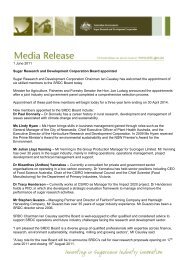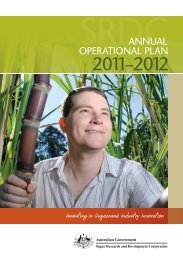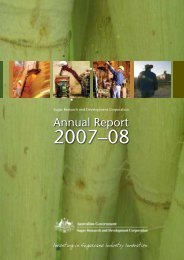Section 2 - Sugar Research and Development Corporation
Section 2 - Sugar Research and Development Corporation
Section 2 - Sugar Research and Development Corporation
Create successful ePaper yourself
Turn your PDF publications into a flip-book with our unique Google optimized e-Paper software.
SRDC fostered the greater use of economic tools<br />
such as gross margin analysis by cane harvesters<br />
<strong>and</strong> growers operators in decision-making with<br />
a focus on profi tability <strong>and</strong> not just productivity.<br />
This aspect until now has been under developed<br />
because key industry organisations generally<br />
did not provide economic advice with extension<br />
programs as it was assumed that high productivity<br />
was best for all sectors of the industry.<br />
SRDC support for extension of economic<br />
information was essential for the rapid adoption<br />
of improved cane farming systems <strong>and</strong> was<br />
achieved in part by funding a wider range of<br />
R&D providers not traditionally used in the sugar<br />
industry. SRDC has long recognised that people<br />
are the key to a prosperous <strong>and</strong> competitive<br />
sugar industry. Traditionally, development of skills<br />
<strong>and</strong> knowledge was through scholarships <strong>and</strong><br />
travel grants but more recently specifi c funding<br />
for grower group R&D projects is returning<br />
greater benefi ts because growers have much<br />
greater ownership of the results <strong>and</strong> are more like<br />
to adopt new <strong>and</strong> improved practices.<br />
Integration of an extension component within<br />
projects is gaining momentum <strong>and</strong> is encouraged<br />
as this speeds adoption. Several extension <strong>and</strong><br />
promotion projects have been funded by SRDC<br />
to identify <strong>and</strong> test new ways of increasing the<br />
rate of adoption of improved technologies <strong>and</strong><br />
best management practices on farm.<br />
IMPACT OF SRDC INVESTMENT ON R&D OUTCOMES<br />
Many projects are providing signifi cant returns<br />
for a relatively small investment – growers are<br />
increasingly taking control of their own R&D<br />
projects <strong>and</strong> working more closely with industry<br />
researchers, rather than relying on other people<br />
to solve on farm issues. Examples of such<br />
successful projects include:<br />
��harvest payment arrangements that provide<br />
incentives for quality product,<br />
��improved harvester design, effi ciency <strong>and</strong><br />
operation,<br />
��harvesting <strong>and</strong> transport of crop to supply<br />
additional fi bre for cogeneration,<br />
��grower-monitoring <strong>and</strong> management of the<br />
quality of water emanating from farms,<br />
��integration of grain legume <strong>and</strong> other cash<br />
crops to improve cane farming systems, <strong>and</strong><br />
��adaption of improved farming systems to suit<br />
local conditions.<br />
SRDC pursues a policy of supporting projects<br />
where economic, environmental <strong>and</strong> social<br />
impacts are all considered when planning <strong>and</strong><br />
evaluating research <strong>and</strong> development projects.<br />
This means that projects are more likely to<br />
provide outcomes that can be readily accessed<br />
<strong>and</strong> adopted by industry people.<br />
SRDC Annual Report 2010–2011 9






